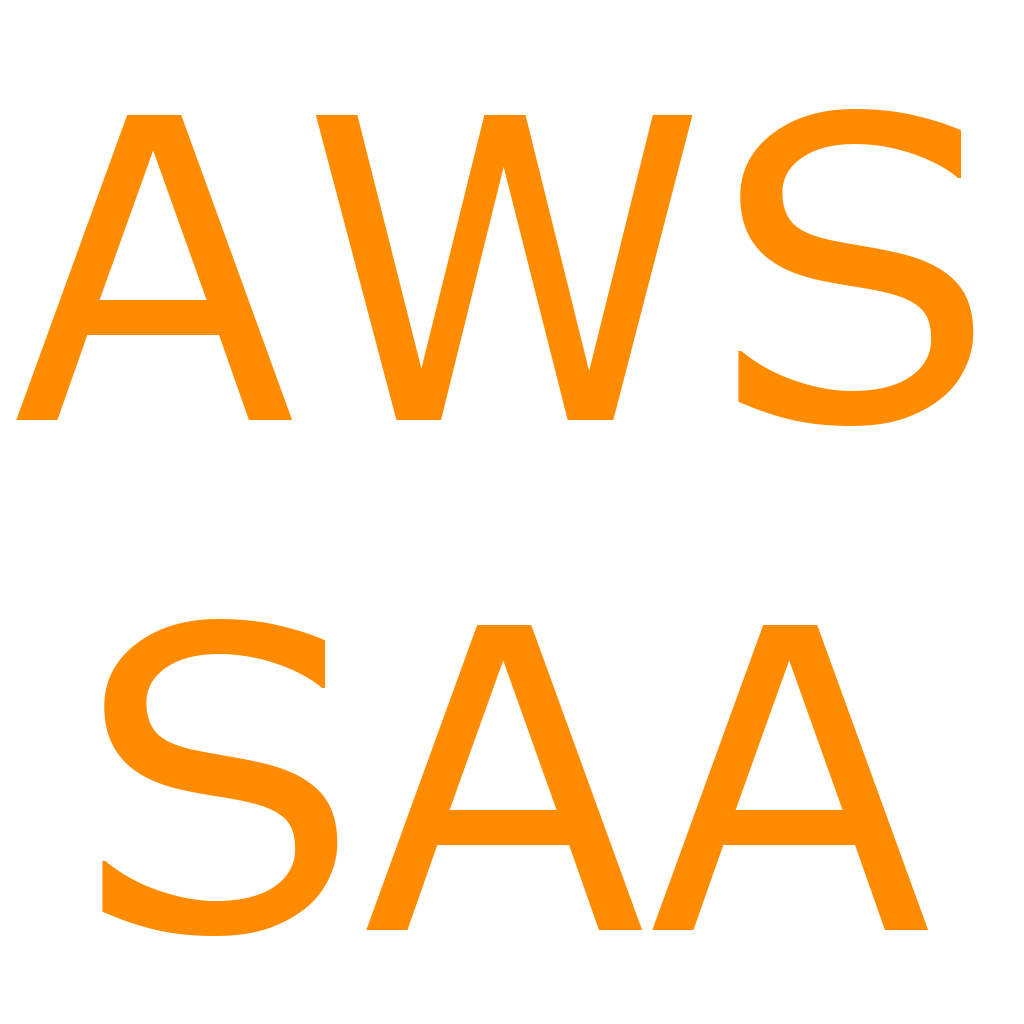AWS Certified Solutions Architect – Associate average salary
The AWS Certified Solutions Architect – Associate average salary is $149,446/
This blog is about the AWS Certification and Training App for Solution Architect Associate, SAA, SAA-C02, SAA-C03. The AWS Certified Solution Architect Associate Practice Exams Quiz App contain 200+ Questions and Answers updated frequently, detailed answers and references, Quizzes for each exam category, score card for each category and mock exam, Score Tracker, countdown timer, Cheat Sheets, Flash Cards, Training Videos, etc.

AWS Solutions Architect Associates SAA-C02 and SAA-C03 Certification Exam Prep
AWS SAA Exam Prep App on iOs
AWS SAA Exam Prep App on android
AWS SAA Exam Prep App on Windows 10/11

Get the AWS SAA-C02 / SAA-C03 Exam Prep App on: iOS – Android – Windows 10/11
AWS Certified Solution Architect Associate Prep App Features:
The app contains questions and answers and resources about:
- Design High Performing Architectures,
- Design Cost Optimized Architectures,
- Design Secure Applications And Architectures,
- Design Resilient Architecture,
- Quiz with score tracking, progress bar, countdown timer and highest score savings.
- Can only see answers after completing the quiz.
- Show/Hide answers button option after completing quiz in each category.
- Ability to navigate through questions for each category using next and previous button.
- Resource info page about the answer for each category and Top 60 Tips to succeed in the exam.
- Questions and Answers updated frequently.
- Ability to study and practice from your mobile device with an intuitive interface.
- SAA-C01 and SAA-C02 compatible
AWS Certified Solution Architect Associate Prep App Videos Previews:
AWS Certified Solution Architect Associate Prep App Urls:

AWS Certified Solution Architect PRO versions for Ios
[appbox appstore 1501465417]
AWS Certified Solution Architect PRO versions for Android google:
[appbox googleplay com.awssolutionarchitectassociateexampreppro.app]
AWS Certified Solution Architect PRO versions for Windows10/11:
AWS Certified Solution Architect PRO versions for Amazon android:
AWS Certified Solution Architect Associate Prep App Content:
Resources section, Various architectural Questions and Answers about AWS, AWS SDK, EBS Volumes, EC2, S3, KMS, AWS read replicas, CloudFront, Elasticity, Virtual Machines, Caching, Containers, Architecture, AWS Security, Lambda, Bastion Hosts, S3 lifecycle policy, kinesis sharing, AWS EBS Volumes, API Gateway, AWS Snapshots, Auto shutdown Ec2 instances, High Availability, RDS, DynamoDB, Elasticity, AWS Virtual Machines, AWS Caching, AWS Containers, AWS Architecture, Load Balancing, EBS, Multi-AZ RDS, Aurora, EFS, NLB, ALB, Aurora, Auto Scaling, DynamoDB(latency), Aurora(performance), Multi-AZ RDS(high availability), Throughput Optimized EBS (highly sequential), CloudWatch, CloudTrail, ElasticBeanstalk, OpsWorks, RPO vs RTO, HA vs FT, Undifferentiated Heavy Lifting, Access Management Basics, Shared Responsibility Model, Cloud Service Models, etc…
The resources sections cover the following areas: Certification, AWS training, Exam Preparation Tips, Cloud Architect Training, Cloud Architecture Knowledge.
Abilities Validated by the AWS Certified Solution Architect Associate Prep App :
- Effectively demonstrate knowledge of how to architect and deploy secure and robust applications using AWS technologies
- Define a solution using architectural design principles based on customer requirements
- Provide implementation guidance based on best practices to the organization throughout the life cycle of the project
AWS Certified Solution Architect Associate Prep App: Exam Preparation Tips:
0
Read FAQs and learn more about the following topics in details: Load Balancing, DynamoDB, EBS, Multi-AZ RDS, Aurora, EFS, DynamoDB, NLB, ALB, Aurora, Auto Scalling, DynamoDB(latency), Aurora(performance), Multi-AZ RDS(high availability), Throughput Optimized EBS (highly sequential), Read the quizlet note cards about Cloudwatch, CloudTrail, KMS, ElasticBeanstalk, OpsWorks here. Read Dexter’s Barely passed AWS Cram Notes about RPO vs RTO, HA vs FT, Undifferentiated Heavy Lifting, Access Management Basics, Shared Responsibility Model, Cloud Service Models
AWS topics for SAA-CO1 and SAA-CO2
1
Know what instance types can be launched from which types of AMIs, and which instance types require an HVM AMIAWS HVM AMI
2
Understand bastion hosts, and which subnet one might live on. Bastion hosts are instances that sit within your public subnet and are typically accessed using SSH or RDP. Once remote connectivity has been established with the bastion host, it then acts as a ‘jump’ server, allowing you to use SSH or RDP to login to other instances (within private subnets) deeper within your network. When properly configured through the use of security groups and Network ACLs, the bastion essentially acts as a bridge to your private instances via the Internet.”
Bastion Hosts
3
Know the difference between Directory Service’s AD Connector and Simple AD. Use Simple AD if you need an inexpensive Active Directory–compatible service with the common directory features. AD Connector lets you simply connect your existing on-premises Active Directory to AWS.
AD Connector and Simple AD
4
Know how to enable cross-account access with IAM: To delegate permission to access a resource, you create an IAM role that has two policies attached. The permissions policy grants the user of the role the needed permissions to carry out the desired tasks on the resource. The trust policy specifies which trusted accounts are allowed to grant its users permissions to assume the role. The trust policy on the role in the trusting account is one-half of the permissions. The other half is a permissions policy attached to the user in the trusted account that allows that user to switch to, or assume the role.
Enable cross-account access with IAM
5
Have a good understanding of how Route53 supports all of the different DNS record types, and when you would use certain ones over others.
Route 53 supports all of the different DNS record types
6
Know which services have native encryption at rest within the region, and which do not.
AWS Services with native Encryption at rest
7
Know which services allow you to retain full admin privileges of the underlying EC2 instances
EC2 Full admin privilege
8
Know When Elastic IPs are free or not: If you associate additional EIPs with that instance, you will be charged for each additional EIP associated with that instance per hour on a pro rata basis. Additional EIPs are only available in Amazon VPC. To ensure efficient use of Elastic IP addresses, we impose a small hourly charge when these IP addresses are not associated with a running instance or when they are associated with a stopped instance or unattached network interface.
When are AWS Elastic IPs Free or not?
9
Know what are the four high level categories of information Trusted Advisor supplies.
#AWS Trusted advisor
10
Know how to troubleshoot a connection time out error when trying to connect to an instance in your VPC. You need a security group rule that allows inbound traffic from your public IP address on the proper port, you need a route that sends all traffic destined outside the VPC (0.0.0.0/0) to the Internet gateway for the VPC, the network ACLs must allow inbound and outbound traffic from your public IP address on the proper port, etc.
#AWS Connection time out error
11
Be able to identify multiple possible use cases and eliminate non-use cases for SWF.
#AWS
12
Understand how you might set up consolidated billing and cross-account access such that individual divisions resources are isolated from each other, but corporate IT can oversee all of it.
#AWS Set up consolidated billing
13
Know how you would go about making changes to an Auto Scaling group, fully understanding what you can and can’t change. “You can only specify one launch configuration for an Auto Scaling group at a time, and you can’t modify a launch configuration after you’ve created it. Therefore, if you want to change the launch configuration for your Auto Scaling group, you must create a launch configuration and then update your Auto Scaling group with the new launch configuration. When you change the launch configuration for your Auto Scaling group, any new instances are launched using the new configuration parameters, but existing instances are not affected.
#AWS Make Change to Auto Scaling group
14
Know how you would go about making changes to an Auto Scaling group, fully understanding what you can and can’t change. “You can only specify one launch configuration for an Auto Scaling group at a time, and you can’t modify a launch configuration after you’ve created it. Therefore, if you want to change the launch configuration for your Auto Scaling group, you must create a launch configuration and then update your Auto Scaling group with the new launch configuration. When you change the launch configuration for your Auto Scaling group, any new instances are launched using the new configuration parameters, but existing instances are not affected.
#AWS Make Change to Auto Scaling group
15
Know which field you use to run a script upon launching your instance.
#AWS User data script
16
Know how DynamoDB (durable, and you can pay for strong consistency), Elasticache (great for speed, not so durable), and S3 (eventual consistency results in lower latency) compare to each other in terms of durability and low latency.
#AWS DynamoDB consistency
17
Know the difference between bucket policies, IAM policies, and ACLs for use with S3, and examples of when you would use each. “With IAM policies, companies can grant IAM users fine-grained control to their Amazon S3 bucket or objects while also retaining full control over everything the users do. With bucket policies, companies can define rules which apply broadly across all requests to their Amazon S3 resources, such as granting write privileges to a subset of Amazon S3 resources. Customers can also restrict access based on an aspect of the request, such as HTTP referrer and IP address. With ACLs, customers can grant specific permissions (i.e. READ, WRITE, FULL_CONTROL) to specific users for an individual bucket or object.
#AWS Difference between bucket policies
18
Know when and how you can encrypt snapshots.
#AWS EBS Encryption
19
Understand how you can use ELB cross-zone load balancing to ensure even distribution of traffic to EC2 instances in multiple AZs registered with a load balancer.
#AWS ELB cross-zone load balancing
20
How would you allow users to log into the AWS console using active directory integration. Here is a link to some good reference material.
#AWS og into the AWS console using active directory integration
21
Spot instances are good for cost optimization, even if it seems you might need to fall back to On-Demand instances if you wind up getting kicked off them and the timeline grows tighter. The primary (but still not only) factor seems to be whether you can gracefully handle instances that die on you–which is pretty much how you should always design everything, anyway!
#AWS Spot instances
22
The term “use case” is not the same as “function” or “capability”. A use case is something that your app/system will need to accomplish, not just behaviour that you will get from that service. In particular, a use case doesn’t require that the service be a 100% turnkey solution for that situation, just that the service plays a valuable role in enabling it.
#AWS use case
23
There might be extra, unnecessary information in some of the questions (red herrings), so try not to get thrown off by them. Understand what services can and can’t do, but don’t ignore “obvious”-but-still-correct answers in favour of super-tricky ones.
#AWS Exam Answers: Distractors
24
If you don’t know what they’re trying to ask, in a question, just move on and come back to it later (by using the helpful “mark this question” feature in the exam tool). You could easily spend way more time than you should on a single confusing question if you don’t triage and move on.
#AWS Exa: Skip Questions that are vague and come back to them later
25
Some exam questions required you to understand features and use cases of: VPC peering, cross-account access, DirectConnect, snapshotting EBS RAID arrays, DynamoDB, spot instances, Glacier, AWS/user security responsibilities, etc.
#AWS
26
The 30 Day constraint in the S3 Lifecycle Policy before transitioning to S3-IA and S3-One Zone IA storage classes
#AWS S3 lifecycle policy
27
Enabling Cross-region snapshot copy for an AWS KMS-encrypted cluster
Redis Auth / Amazon MQ / IAM DB Authentication
#AWS Cross-region snapshot copy for an AWS KMS-encrypted cluster
28
Know that FTP is using TCP and not UDP (Helpful for questions where you are asked to troubleshoot the network flow)
TCP and UDP
29
Know the Difference between S3, EBS and EFS
#AWS Difference between S3, EBS and EFS
30
Kinesis Sharding:
#AWS Kinesis Sharding
31
Handling SSL Certificates in ELB ( Wildcard certificate vs SNI )
#AWS Handling SSL Certificates in ELB ( Wildcard certificate vs SNI )
32
Difference between OAI, Signed URL (CloudFront) and Pre-signed URL (S3)
#AWS Difference between OAI, Signed URL (CloudFront) and Pre-signed URL (S3)
33
Different types of Aurora Endpoints
#AWS Different types of Aurora Endpoints
34
The Default Termination Policy for Auto Scaling Group (Oldest launch configuration vs Instance Protection)
#AWS Default Termination Policy for Auto Scaling Group
35
Watch Acloud Guru Videos Lectures while commuting / lunch break – Reschedule the exam if you are not yet ready
#AWS ACloud Guru
36
Watch Linux Academy Videos Lectures while commuting / lunch break – Reschedule the exam if you are not yet ready
#AWS Linux Academy
37
Watch Udemy Videos Lectures while commuting / lunch break – Reschedule the exam if you are not yet ready
#AWS Linux Academy
38
The Udemy practice test interface is good that it pinpoints your weak areas, so what I did was to re-watch all the videos that I got the wrong answers. Since I was able to gauge my exam readiness, I decided to reschedule my exam for 2 more weeks, to help me focus on completing the practice tests.
#AWS Udemy
39
Use AWS Cheatsheets – I also found the cheatsheets provided by Tutorials Dojo very helpful. In my opinion, it is better than Jayendrapatil Patil’s blog since it contains more updated information that complements your review notes.
#AWS Cheat Sheet
40
Watch this exam readiness 3hr video, it very recent webinar this provides what is expected in the exam.
#AWS Exam Prep Video
41
Start off watching Ryan’s videos. Try and completely focus on the hands on. Take your time to understand what you are trying to learn and achieve in those LAB Sessions.
#AWS Exam Prep Video
42
Do not rush into completing the videos. Take your time and hone the basics. Focus and spend a lot of time for the back bone of AWS infrastructure – Compute/EC2 section, Storage (S3/EBS/EFS), Networking (Route 53/Load Balancers), RDS, VPC, Route 3. These sections are vast, with lot of concepts to go over and have loads to learn. Trust me you will need to thoroughly understand each one of them to ensure you pass the certification comfortably.
#AWS Exam Prep Video
43
Make sure you go through resources section and also AWS documentation for each components. Go over FAQs. If you have a question, please post it in the community. Trust me, each answer here helps you understand more about AWS.
#AWS Faqs
44
Like any other product/service, each AWS offering has a different flavor. I will take an example of EC2 (Spot/Reserved/Dedicated/On Demand etc.). Make sure you understand what they are, what are the pros/cons of each of these flavors. Applies for all other offerings too.
#AWS Services
45
Ensure to attend all quizzes after each section. Please do not treat these quizzes as your practice exams. These quizzes are designed to mostly test your knowledge on the section you just finished. The exam itself is designed to test you with scenarios and questions, where in you will need to recall and apply your knowledge of different AWS technologies/services you learn over multiple lectures.
#AWS Services
46
I, personally, do not recommend to attempt a practice exam or simulator exam until you have done all of the above. It was a little overwhelming for me. I had thoroughly gone over the videos. And understood the concepts pretty well, but once I opened exam simulator I felt the questions were pretty difficult. I also had a feeling that videos do not cover lot of topics. But later I realized, given the vastness of AWS Services and offerings it is really difficult to encompass all these services and their details in the course content. The fact that these services keep changing so often, does not help
#AWS Services
47
Go back and make a note of all topics, that you felt were unfamiliar for you. Go through the resources section and fiund links to AWS documentation. After going over them, you shoud gain at least 5-10% more knowledge on AWS. Have expectations from the online courses as a way to get thorough understanding of basics and strong foundations for your AWS knowledge. But once you are done with videos. Make sure you spend a lot of time on AWS documentation and FAQs. There are many many topics/sub topics which may not be covered in the course and you would need to know, atleast their basic functionalities, to do well in the exam.
#AWS Services
48
Once you start taking practice exams, it may seem really difficult at the beginning. So, please do not panic if you find the questions complicated or difficult. IMO they are designed or put in a way to sound complicated but they are not. Be calm and read questions very carefully. In my observation, many questions have lot of information which sometimes is not relevant to the solution you are expected to provide. Read the question slowly and read it again until you understand what is expected out of it.
#AWS Services
49
With each practice exam you will come across topics that you may need to scale your knowledge on or learn them from scratch.
#AWS Services
50
With each test and the subsequent revision, you will surely feel more confident.
There are 130 mins for questions. 2 mins for each question which is plenty of time.
At least take 8-10 practice tests. The ones on udemy/tutorialdojo are really good. If you are a acloudguru member. The exam simulator is really good.
Manage your time well. Keep patience. I saw someone mention in one of the discussions that do not under estimate the mental focus/strength needed to sit through 130 mins solving these questions. And it is really true.
Do not give away or waste any of those precious 130 mins. While answering flag/mark questions you think you are not completely sure. My advice is, even if you finish early, spend your time reviewing the answers. I could review 40 of my answers at the end of test. And I at least rectified 3 of them (which is 4-5% of total score, I think)
So in short – Put a lot of focus on making your foundations strong. Make sure you go through AWS Documentation and FAQs. Try and envision how all of the AWS components can fit together and provide an optimal solution. Keep calm.
This video gives outline about exam, must watch before or after Ryan’s course. #AWS Services
51
Walking you through how to best prepare for the AWS Certified Solutions Architect Associate SAA-C02 exam in 5 steps:
1. Understand the exam blueprint
2. Learn about the new topics included in the SAA-C02 version of the exam
3. Use the many FREE resources available to gain and deepen your knowledge
4. Enroll in our hands-on video course to learn AWS in depth
5. Use practice tests to fully prepare yourself for the exam and assess your exam readiness
AWS CERTIFIED SOLUTIONS ARCHITECT SAA-C02 : HOW TO BEST PREPARE IN 5 STEPS
52
Storage:
1. Know your different Amazon S3 storage tiers! You need to know the use cases, features and limitations, and relative costs; e.g. retrieval costs.
2. Amazon S3 lifecycle policies is also required knowledge — there are minimum storage times in certain tiers that you need to know.
3. For Glacier, you need to understand what it is, what it’s used for, and what the options are for retrieval times and fees.
4. For the Amazon Elastic File System (EFS), make sure you’re clear which operating systems you can use with it (just Linux).
5. For the Amazon Elastic Block Store (EBS), make sure you know when to use the different tiers including instance stores; e.g. what would you use for a datastore that requires the highest IO and the data is distributed across multiple instances? (Good instance store use case)
6. Learn about Amazon FSx. You’ll need to know about FSx for Windows and Lustre.
7. Know how to improve Amazon S3 performance including using CloudFront, and byte-range fetches — check out this whitepaper.
8. Make sure you understand about Amazon S3 object deletion protection options including versioning and MFA delete.
AWS CERTIFIED SOLUTIONS ARCHITECT SAA-C02 : HOW TO BEST PREPARE IN 5 STEPS
53
Compute:
1. You need to have a good understanding of the options for how to scale an Auto Scaling Group using metrics such as SQS queue depth, or numbers of SNS messages.
2. Know your different Auto Scaling policies including Target Tracking Policies.
3. Read up on High Performance Computing (HPC) with AWS. You’ll need to know about Amazon FSx with HPC use cases.
4. Know your placement groups. Make sure you can differentiate between spread, cluster and partition; e.g. what would you use for lowest latency? What about if you need to support an app that’s tightly coupled? Within an AZ or cross AZ?
5. Make sure you know the difference between Elastic Network Adapters (ENAs), Elastic Network Interfaces (ENIs) and Elastic Fabric Adapters (EFAs).
6. For the Amazon Elastic Container Service (ECS), make sure you understand how to assign IAM policies to ECS for providing S3 access. How can you decouple an ECS data processing process — Kinesis Firehose or SQS?
7. Make sure you’re clear on the different EC2 pricing models including Reserved Instances (RI) and the different RI options such as scheduled RIs.
8. Make sure you know the maximum execution time for AWS Lambda (it’s currently 900 seconds or 15 minutes).
AWS CERTIFIED SOLUTIONS ARCHITECT SAA-C02 : HOW TO BEST PREPARE IN 5 STEPS
54
Network
1. Understand what AWS Global Accelerator is and its use cases.
2. Understand when to use CloudFront and when to use AWS Global Accelerator.
3. Make sure you understand the different types of VPC endpoint and which require an Elastic Network Interface (ENI) and which require a route table entry.
4. You need to know how to connect multiple accounts; e.g. should you use VPC peering or a VPC endpoint?
5. Know the difference between PrivateLink and ClassicLink.
6. Know the patterns for extending a secure on-premises environment into AWS.
7. Know how to encrypt AWS Direct Connect (you can use a Virtual Private Gateway / AWS VPN).
8. Understand when to use Direct Connect vs Snowball to migrate data — lead time can be an issue with Direct Connect if you’re in a hurry.
9. Know how to prevent circumvention of Amazon CloudFront; e.g. Origin Access Identity (OAI) or signed URLs / signed cookies.
AWS CERTIFIED SOLUTIONS ARCHITECT SAA-C02 : HOW TO BEST PREPARE IN 5 STEPS
55
Databases
1. Make sure you understand Amazon Aurora and Amazon Aurora Serverless.
2. Know which RDS databases can have Read Replicas and whether you can read from a Multi-AZ standby.
3. Know the options for encrypting an existing RDS database; e.g. only at creation time otherwise you must encrypt a snapshot and create a new instance from the snapshot.
4. Know which databases are key-value stores; e.g. Amazon DynamoDB.
AWS CERTIFIED SOLUTIONS ARCHITECT SAA-C02 : HOW TO BEST PREPARE IN 5 STEPS
56
Application Integration
1. Make sure you know the use cases for the Amazon Simple Queue Service (SQS), and Simple Notification Service (SNS).
2. Understand the differences between Amazon Kinesis Firehose and SQS and when you would use each service.
3. Know how to use Amazon S3 event notifications to publish events to SQS — here’s a good “How To” article.
AWS CERTIFIED SOLUTIONS ARCHITECT SAA-C02 : HOW TO BEST PREPARE IN 5 STEPS
57
Management and Governance
1. You’ll need to know about AWS Organizations; e.g. how to migrate an account between organizations.
2. For AWS Organizations, you also need to know how to restrict actions using service control policies attached to OUs.
3. Understand what AWS Resource Access Manager is.
AWS CERTIFIED SOLUTIONS ARCHITECT SAA-C02 : HOW TO BEST PREPARE IN 5 STEPS
58
Jon Bonso list of helpful exam prep materials that you can use.
1. The official AWS SAA-C02 Certification Exam page.
2. The official AWS Exam Guide.
3. The official AWS Sample Questions
4. The official AWS Ramp-Up Guide: Architect PDF
5. Tutorials Dojo SAA-C02 Study Guide
6. Udemy Practice Exams
7. New AWS Services to prepare for:AWS Global Accelerator
8. New AWS Services to prepare for: Elastic Fabric Adapter — Amazon Web Services
9. New AWS Services to prepare for: AWS ParallelCluster – Amazon Web Services
10. New AWS Services to prepare for: Amazon FSx File Storage
Pass your SAA-C02 (AWS Solutions Architect Associate) exam with these Top 5 Resources
Other AWS Certified Solution Architect Associate Prep App
- AWS S3 facts and summaries and Q&A Dump
- AWS DynamoDB facts and summaries and Questions and Answers Dump
- AWS EC2 facts and summaries and Questions and Answers Dump
- AWS Serverless facts and summaries and Questions and Answers Dump
- AWS Developer and Deployment Theory facts and summaries and Questions and Answers Dump
- AWS IAM facts and summaries and Questions and Answers Dump
- AWS vs Azure vs Google
- Pros and Cons of Cloud Computing
- Cloud Customer Insurance – Cloud Provider Insurance – Cyber Insurance
AWS Certified Solution Architect Associate Prep App: Additional Information for reference
Get the AWS SAA SAA-C02 SAA-C03 Exam Prep App on: iOS – Android – Windows 10/11
Below are some useful reference links that would help you to learn about AWS Practitioner Exam.
- AWS certified Solution Architect Associate
- certification faqs
- AWS Certified Solution Architect Associate Exam Prep Dumps
AWS Certified Solution Architect Associate Prep: Whitepapers:
AWS has provided whitepapers to help you understand the technical concepts. Below are the recommended whitepapers.
Note and disclaimer: We are not affiliated with AWS or Amazon or Microsoft or Google. The questions are put together based on the certification study guide and materials available online. We also receive questions and answers from anonymous users and we vet to make sure they are legitimate. The questions in this app should help you pass the exam but it is not guaranteed. We are not responsible for any exam you did not pass.
Important: To succeed with the real exam, do not memorize the answers in this app. It is very important that you understand why a question is right or wrong and the concepts behind it by carefully reading the reference documents in the answers.

Get the AWS SAA SAA-C02 SAA-C03 Exam Prep App on: iOS – Android – Windows 10/11




